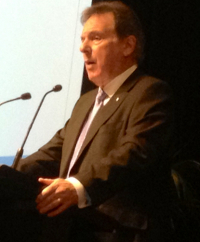FttN, HFC are dead-end NBN alternatives: Samuel

Australians have a "fundamental" Howard government mistake to thank for the structural separation of Telstra, retirement of "congested" cable-broadband networks, and construction of a fibre National Broadband Network (NBN) that's cheaper than earlier alternatives, former ACCC head Graeme Samuel has argued.

Samuel ran the competition regulator for eight years, and repeatedly faced off against combative Telstra CEO Sol Trujillo. He now heads the Melbourne office of corporate advisory firm Greenhill Caliburn, and he told the Australian 2012 IPv6 Summit today that Trujillo's relationship with the regulator dramatically changed the course of the telecommunications industry.
"Looking at the new Telstra that we have under the leadership of Catherine Livingston as chair and David Thodey as CEO," he said, "let me say that had they been in place in 2005, we might have a whole new telecoms paradigm in this country from what we got as a consequence of the engagement of Trujillo and [regulatory head Phil] Burgess."
Yet, that engagement provided impetus for the rejection of a prior fibre-to-the-node (FttN) NBN: "We ought to be grateful for that fundamental error having been made," Samuel said. "It ultimately said to the government that if you want to sort this out, you have to go through the major process of structural separation that we now have in place."
Recounting the process by which Telstra's non-compliant FttN proposal was rejected in December 2008, Samuel said that careful consideration of the three compliant bids had confirmed that FttN — when paired with the estimated AU$20 billion cost of accessing copper from an unseparated Telstra — simply wasn't economically viable.
Mooted wholesale pricing for the FttN network was far higher than that currently being proposed by NBN Co over its fibre-to-the-premises (FttP) network.
"I'm not at liberty to reveal the wholesale costs that would have been charged on the [FttN] network, but suffice it to say that they do not compare favourably with some of the costs now being talked about for [Labor's] FttH [fibre-to-the-home] network."
Even with Telstra structurally separated, Samuel said that it would be wrong to revert to an FttN NBN infrastructure, as has been repeatedly mooted by opposition communications spokesperson Malcolm Turnbull.
"Back in January 2009, the fundamental message we could give the expert panel regarding FttN was that it would not cost AU$4.7 billion, but would ultimately end up costing many times that," Samuel said.
"Should we return to FttN? In my view, no — for the same reason we didn't go to FttN in the first place."
Turnbull has repeatedly argued that the Coalition's yet-to-be-detailed NBN alternative plan would deliver broadband faster and cheaper than Labor's current program. Samuel did allow that the complexity of running fibre into multiple dwelling units (MDUs) might require the use of local fixed-wireless services as an alternative to fibre in some cases: "many older MDUs don't have service cores that make it easy to run fibre optics to individual premises," he said. "There might be an argument to substitute some sort of fixed wireless to make that easier."
However, he is sceptical of claims that FttN is an intermediate step to FttP, noting that an expected investment of more than AU$10 billion in "thousands" of street-corner FttN nodes would need to be recovered before the country could even begin considering a later move to FttP.
Samuel is equally sceptical about the long-term relevance of Telstra and Optus' hybrid fibre-coaxial (HFC) networks, upon which Turnbull's policy will depend.
"I think it is highly unlikely to be a longer-term competitive infrastructure to the NBN," he explained. "What has happened with HFC is that more and more data is being pushed down, and at this point in time, it's suffering contention issues."
HFC networks have gotten so bad that Samuel joked that he advises neighbours at the street Christmas party not to subscribe to Telstra's "hopeless" HFC — just so "at least I can continue to get reasonable speeds at 8 p.m."
"Fortunately, most people listen to me as the local expert on the subject, and don't go onto Telstra's cable for their broadband," he laughed. "It's a great relief in my street."